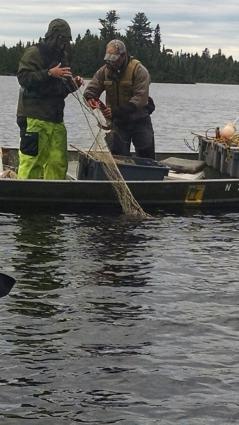Legacy of Hunting and Trapping on the North Shore

This project focuses on the diverse cultural and historical aspects of life in the rich outdoor setting on the North Shore. It explores the history and current methods of hunting and trapping in the region. Through storytelling and community voices, WTIP explores the historical role of hunting throughout the entire community, as well as the cultural significance hunting continues to play for members of the Grand Portage Band of Lake Superior Chippewa.
This series also explores how local youth throughout Cook County about how they got involved with hunting in 2019 or recent years, and how this longstanding tradition on the North Shore has shaped human culture in the North Woods.
Support for this series comes from the Minnesota Arts & Cultural Heritage Fund.
Trapping traditions continue along the North Shore
Joe Friedrichs-For Jim Wallner and his family in Cook County, an early winter tradition includes setting trap lines in the nearby forests.
Trapping is something Wallner has been doing for many years, and a practice he still finds rewarding.
The legacy of hunting and trapping in Cook County and the North Shore area stretches back for as long as humans lived in the region.
For generations and dating back many hundreds of years the native communities have hunted these lands. The furs and meat of various species were essential for their survival in the far north. After their arrival, Voyageurs from the interior of Canada would carry their furs by canoe through the boundary waters region on their way to Lake Superior.
The necessity for trapping and the popularity of the trade is far different from what it was several generations ago. That being the case, Minnesota Department of Natural Resources' Furbearer Research Specialist John Erb says some, including Wallner, still look forward to the trapping season each winter.
In this installment of the WTIP original series “The Legacy of Hunting and Trapping on the North Shore,” Joe Friedrichs visits the Wallner house to learn more about trapping in the region.
The brutal joys of netting fish on the Gunflint Trail
Joe Friedrichs-Recreational netting for whitefish and cisco is currently open on designated lakes in Cook County. There are six lakes that open to netting in the late fall and early portion of the winter. Three of these lakes, Brule, Caribou and East Pike, are found entirely within the Boundary Waters Canoe Area Wilderness. The three other lakes – Greenwood, Poplar and Devil Track – are more commonly used for whitefish and cisco netting due to their easy access and the fact motors can be used to place and check nets.
Whitefish and cisco sport netting is open to Minnesota residents only. Anyone who is a resident of the state and possesses a fishing license can simply add on the tag to net whitefish and cisco on these designated lakes for the low cost of $10 per year. The Minnesota Department of Natural Resources reports that a total of about 700 Minnesotans participate annually, with 50 or so engaging in the activity in Cook County each year.
Whitefish netting schedules are based on expected water temperatures for Devil Track, Poplar and Greenwood. As the water temperature cools, game fish head to deeper water while whitefish come to shallow water for fall spawning.
The DNR allows netting when there is little chance that game fish populations would be negatively impacted by recreational netting in shallow water. Game fish, including walleye, northern pike, lake trout or smallmouth, that are accidentally taken in nets must be returned to the water immediately.
WTIP’s Joe Friedrichs recently ventured across the choppy waters of Devil Track Lake with local residents Joey Pederson and Matt Nesheim as they checked their fishing nets for the final time of the 2019 season. The audio posted below shares details from their successful outing. Click on the photo above to see more images from their outing.
This story was funded in part by the Minnesota Arts and Cultural Heritage Fund.





